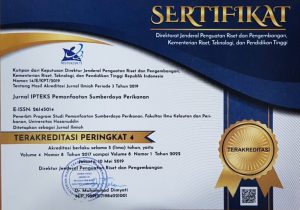Keragaan Biologi Populasi Ikan Cakalang (katsuwonus pelamis) yang Tertangkap dengan Purse Seine pada Musim Timur di Perairan Laut Flores
DOI:
https://doi.org/10.20956/jipsp.v1i2.68Abstract
Biological performance of skipjack tuna has been done in the Flores Sea during the southeast monsoon (June - August, 2013). The objective of the research was to analyze biological performance of skipjack tuna captured by purse seine: including size composition,age classes, growth rate, food habit, gonad maturity and suitable length for capture. The data for length structure and age class, the growth rate, food habit, gonad maturity, and volumetric fecundity estimation were analyzed using Bhattacharya, Von Bertalanffy, propendance index, histological and volumentric methods, respectively. The results showed that (1) the size structure and age class were different according to the fishing ground location and the fishing season, (2) the average size of fishes captured in the western part of Flores Sea was greater than the eastern one, (3) the average length of fishes catched by purse seine without fish aggregation device (FAD, rumpon) was longer than that of with FAD, (4) the growth rate of skipjack tuna was slow where the growth coefficient was less than 0,5 per year, and the asymptotic length was 106,0 cm FL, (5) the skipjack tuna achieved the mature stage at 45 cm and at 50 cm length for female and male, respectively, and ready to spawn at 55 cm and 60 cm for male and female , respectively, (6) it was more than 80 % of fishes captured by fishermen in the Flores Sea which were not yet suitable size for fishing.














